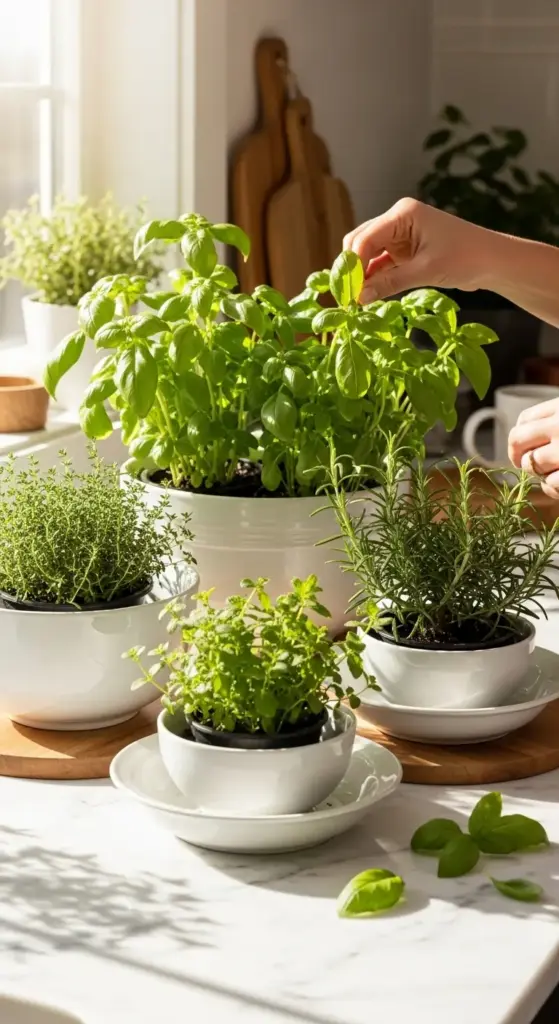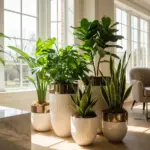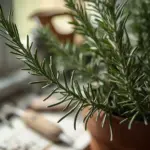2. The Herb Garden Kitchen Display

I’ll never forget the first time I cooked with fresh basil from my own kitchen counter. It was like tasting sunshine compared to those sad, wilted leaves from the grocery store.
But let me be honest – my first attempt at a kitchen herb garden was a complete disaster that left water stains on my marble countertop and dead plants everywhere.
The Four Herbs That Actually Thrive Indoors
Basil is hands down the easiest herb to start with, despite what everyone says about it being “finicky.” The trick is keeping it warm and giving it consistent moisture.
I grow ‘Genovese’ basil because it’s perfect for pasta dishes, but ‘African Blue’ basil has these gorgeous purple flowers that look amazing in photos.
Thyme is practically bulletproof once you get it established. I’ve had the same English thyme plant for over a year now, and it just keeps giving.
Rosemary took me three tries to get right. This Mediterranean herb hates wet feet more than my teenage daughter hates doing dishes. Well-draining soil is absolutely critical.
Mint grows like crazy – almost too well. I learned to keep it in its own container because it’ll take over everything else faster than you can make mojitos.
Containers That Don’t Scream “Crazy Plant Lady”
Forget those plastic pots from the nursery. Your kitchen herb display should look intentional, not like an afterthought.
White ceramic planters work with literally any kitchen style. I found mine at Target for under $15 each, and they still look expensive two years later.
Galvanized metal containers give that perfect farmhouse vibe if that’s your aesthetic. Just make sure they have drainage holes – I learned this lesson the expensive way.
For modern kitchens, those sleek concrete planters are gorgeous. They’re heavier than they look though, so consider that if you’re putting them on floating shelves.
The Drainage System That Saves Your Countertops
This is where I made my biggest rookie mistake. Water damage on countertops is no joke, especially if you’re renting.
Saucers are non-negotiable for any indoor herb garden. But here’s the thing nobody tells you – those cheap plastic ones crack and leak over time.
I swear by glazed ceramic saucers now. They cost a bit more upfront but they’ve saved me from so many potential disasters.
Cork trivets under your saucers add an extra layer of protection. Plus they look intentional and stylish, not like you’re paranoid about water damage.
For extra peace of mind, I put a thin waterproof mat under my entire herb display. You can find clear ones that are practically invisible.
Labeling That Actually Looks Good
Those plastic plant tags from the store? Trash them immediately. They make your beautiful herb garden look like a science experiment.
Chalkboard plant markers are my absolute favorite. You can rewrite them when you change plants, and they photograph beautifully for social media.
Copper plant markers develop this gorgeous patina over time. I write on them with a metal stamp set I got on Amazon for like $20.
For a more minimalist look, wooden plant stakes with simple black lettering work perfectly. I use a fine-tip Sharpie and seal it with clear nail polish.
Avoid anything too cutesy – your herb garden should enhance your kitchen’s style, not clash with it.
The Realistic Maintenance Schedule
Let’s be real about this. You’re busy, and your herbs need to fit into your actual life, not some Pinterest fantasy.
Check soil moisture twice a week by sticking your finger about an inch down. If it’s dry, water thoroughly until it drains out the bottom.
Morning watering works best because it gives plants time to dry before evening. I do this while my coffee brews – it’s become part of my routine.
Harvest regularly even if you don’t need the herbs right away. Pinching off the top growth keeps plants bushy and productive.
Rotate your containers a quarter turn each week so all sides get equal light. This prevents that sad, leaning-toward-the-window look.
Fertilize monthly with a diluted liquid fertilizer. I use fish emulsion because it works amazingly well, even though it smells terrible for about an hour.
Ready to create something even more magical? The next section reveals how to build an enchanting fairy garden that’ll make your guests do double-takes. I’m talking tiny houses, miniature pathways, and the secret to keeping everything perfectly scaled. Click “next” to discover the whimsical world that transformed my boring coffee table!









GIPHY App Key not set. Please check settings